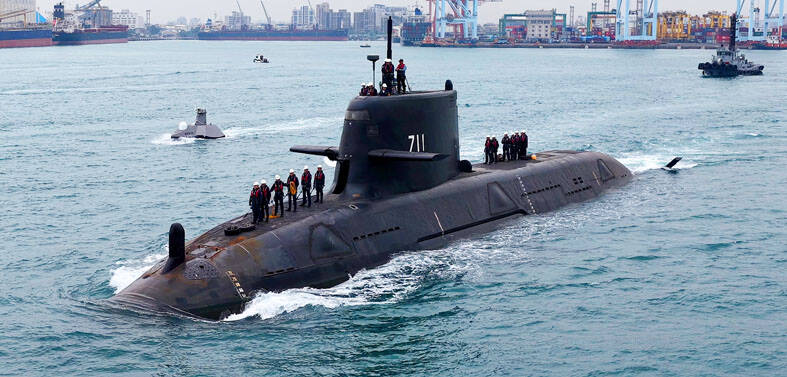A 90-year-old railway in New Taipei City’s Wulai District (烏來) was reopened yesterday after nearly two years of reconstruction following Typhoon Soudelor.
The train’s three carriages transport passengers 1.5km between Wulai Station and Waterfall Station.
There will be a discounted fare of NT$30 until the end of next month.

Photo: Chang An-chiao, Taipei Times
The railway is a landmark of the district along with Wulai Waterfall, Lansheng Bridge and Neidong National Forest Recreation Park, Premier Lin Chuan (林全) said at the reopening ceremony, adding that the area has the potential to become an international tourist attraction.
The originally hand-pulled railway was built in 1928 during the Japanese colonial period to transport logs, tea and passengers, Forestry Bureau Director-General Lin Hua-ching (林華慶) said.
“After the highway was completed in 1951, most sections of the railway were demolished except for the 1.5km portion,” he said.
Typhoon Soudelor in August 2015 caused serious damage to the remaining portion of the railway, 120m of which completely collapsed, he said.
“Much of the reconstruction work was done by hand as big machines could not operate on the narrow roads,” he said, adding that the work was finished last month.
Chu Hung-chi (朱鴻基), who used to pull the carts as a teenager, gave many photographs to a museum by Wulai Station.
Chu said that in the 1960s, he met many tourists from the US who would give him enough tips in a single day to purchase a bag of rice.
His two grandsons said they were glad to see the railway reopen, but expressed hope that the Aboriginal Atayal people’s culture could be featured more in local tourism.
The railway closure dealt a blow to local businesses, a cafe shopkeeper surnamed Lin (林) said, adding that their cafe only barely stayed afloat thanks to some regulars and bicyclists.
“When the typhoon struck, our houses were washed over by mudslides because the bureau did not properly maintain fortifications on the slope,” Lin said, adding that they were still negotiating compensation with bureau officials.

US climber Alex Honnold is to attempt to scale Taipei 101 without a rope and harness in a live Netflix special on Jan. 24, the streaming platform announced on Wednesday. Accounting for the time difference, the two-hour broadcast of Honnold’s climb, called Skyscraper Live, is to air on Jan. 23 in the US, Netflix said in a statement. Honnold, 40, was the first person ever to free solo climb the 900m El Capitan rock formation in Yosemite National Park — a feat that was recorded and later made into the 2018 documentary film Free Solo. Netflix previewed Skyscraper Live in October, after videos

NUMBERS IMBALANCE: More than 4 million Taiwanese have visited China this year, while only about half a million Chinese have visited here Beijing has yet to respond to Taiwan’s requests for negotiation over matters related to the recovery of cross-strait tourism, the Tourism Administration said yesterday. Taiwan’s tourism authority issued the statement after Chinese-language daily the China Times reported yesterday that the government’s policy of banning group tours to China does not stop Taiwanese from visiting the country. As of October, more than 4.2 million had traveled to China this year, exceeding last year. Beijing estimated the number of Taiwanese tourists in China could reach 4.5 million this year. By contrast, only 500,000 Chinese tourists are expected in Taiwan, the report said. The report

Temperatures are forecast to drop steadily as a continental cold air mass moves across Taiwan, with some areas also likely to see heavy rainfall, the Central Weather Administration (CWA) said. From today through early tomorrow, a cold air mass would keep temperatures low across central and northern Taiwan, and the eastern half of Taiwan proper, with isolated brief showers forecast along Keelung’s north coast, Taipei and New Taipei City’s mountainous areas and eastern Taiwan, it said. Lows of 11°C to 15°C are forecast in central and northern Taiwan, Yilan County, and the outlying Kinmen and Lienchiang (Matsu) counties, and 14°C to 17°C

STEERING FAILURE: The first boat of its class is experiencing teething issues as it readies for acceptance by the navy, according to a recent story about rudder failure The Hai Kun (海鯤), the nation’s first locally built submarine, allegedly suffered a total failure of stern hydraulic systems during the second round of sea acceptance trials on June 26, and sailors were forced to manually operate the X-rudder to turn the submarine and return to port, news Web site Mirror Daily reported yesterday. The report said that tugboats following the Hai Kun assisted the submarine in avoiding collisions with other ships due to the X-rudder malfunctioning. At the time of the report, the submarine had completed its trials and was scheduled to begin diving and surfacing tests in shallow areas. The X-rudder,